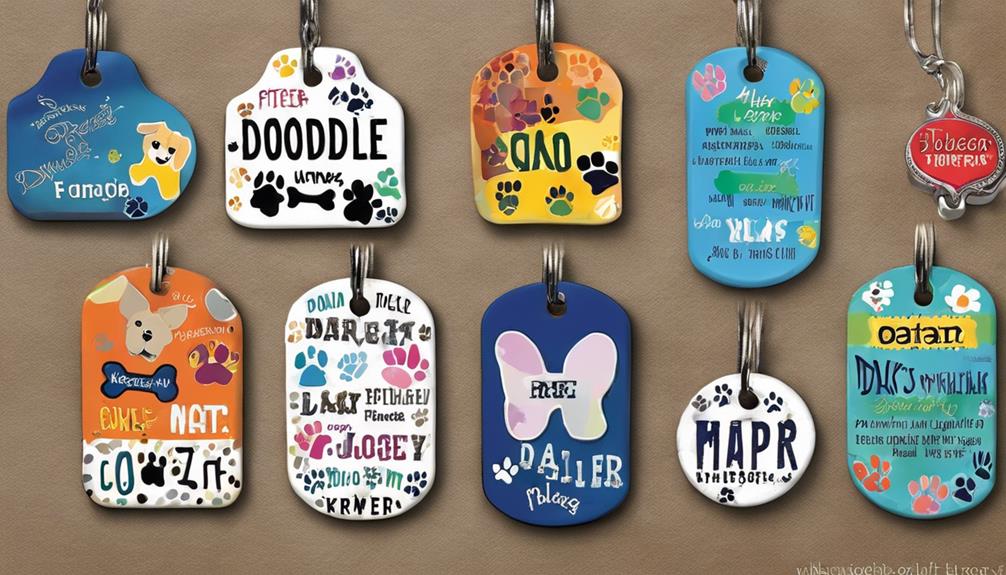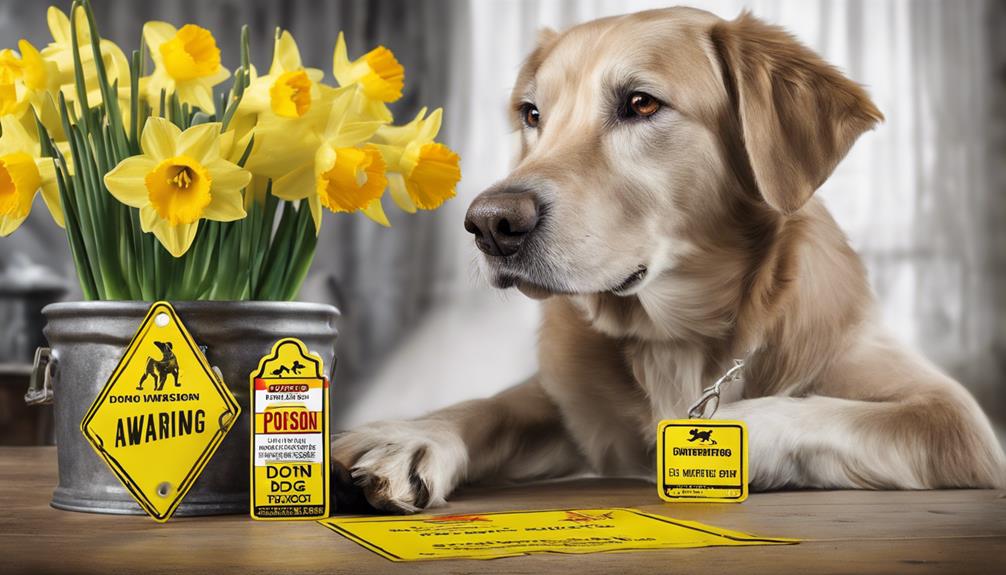To assess your dog's happiness, watch their behavior and body language closely. Happy dogs show relaxed eyes, loose muscles, and playful actions. Tail wags come in various forms, conveying different emotions. Dog kisses also express feelings. Provide mental stimulation with toys and exercise to keep your furry friend happy. Remember, happy dogs are healthy dogs!
Key Takeaways
- Observe body language for happiness cues
- Provide mental stimulation and playtime
- Ensure regular exercise for physical health
- Maintain a comfortable and safe environment
- Seek professional guidance for behavior concerns
Importance of Assessing Dog Happiness
Evaluating our dog's happiness is crucial for ensuring their well-being and quality of life. A happy dog is a healthy dog, both mentally and physically. By observing our furry friend's happiness, we can address any potential issues and make enhancements to their environment.
Monitoring our dog's behavior and body language gives us valuable insights into their emotional well-being. Happy dogs display behaviors like wagging tails, playful interactions, and relaxed body language. On the other hand, signs of unhappiness may include withdrawn behavior, excessive barking, or destructive tendencies. By recognizing these cues, we can take proactive steps to enhance our dog's happiness.
This may involve providing mental stimulation, ensuring regular exercise, or creating a safe and comfortable space for our canine companion. Assessing and improving our dog's happiness strengthens our bond with them and fosters a positive and loving relationship. By prioritizing our dog's happiness, we can create a joyful and fulfilling life for our beloved pet.
Understanding Your Dogs Behavior

When it comes to understanding your dog's behavior, it's crucial to pay attention to their body language. Dogs use different cues like tail wagging, facial expressions, and overall posture to communicate their emotions.
Recognizing these signals can help you evaluate your dog's mental well-being and make sure they're happy and healthy.
Canine Behavior Cues
Observing your dog's body language, facial expressions, and vocalizations is vital for understanding their behavior cues. Here are some key points to help you interpret your canine companion's signals:
- Tail Wagging: While commonly associated with happiness, tail wagging can also convey other emotions based on the context and accompanying body language.
- Dog Kisses: A dog's kisses can have various meanings, from showing affection to indicating stress or anxiety. Pay attention to the situation to understand the message behind these gestures.
- Overall Body Movements: It's important to observe your dog's entire body language to accurately interpret their mood and emotions. By being attentive to these cues, you can strengthen your bond and communication with your furry friend.
Communication Signals in Dogs
To better understand our canine companions, it's important to recognize and interpret the communication signals they use to express their emotions and behavior. Dogs communicate happiness through body language cues such as wagging tails, relaxed body posture, and happy facial expressions. Understanding a dog's body language is vital for accurately interpreting their emotions. Different tail wags can indicate various emotions beyond just happiness, such as excitement, anxiety, or aggression. Dog kisses can also convey different meanings depending on the context and the individual dog's personality. By learning to read and interpret your dog's communication signals, you can strengthen your bond and improve your relationship with your furry friend.
| Body Language Cue | Meaning |
|---|---|
| Wagging tail | Happiness, excitement, anxiety, or aggression depending on the wag |
| Relaxed body posture | Contentment, relaxation, and a sense of ease |
| Happy facial expressions | Joy, pleasure, and a positive emotional state |
Dog Body Language
Understanding your dog's behavior through their body language is essential for strengthening your bond and enhancing your relationship with them.
Here are three key points to help you interpret your dog's body language effectively:
- Tail Wagging: A happy dog will often wag its tail gently with a relaxed body, but different tail wags can convey various emotions beyond just happiness.
- Facial Expressions: A happy dog typically has a relaxed face, with soft eyes and a slightly open mouth. Pay attention to their overall expression to gauge their mood.
- Overall Body Movements: A happy dog will exhibit loose and relaxed body language, possibly with a playful bounce or wiggle. Observing their entire body can give you valuable insight into their emotional state.
Creating a Happy Environment for Your Dog

Ensuring a safe and comfortable home environment is essential for fostering your dog's happiness. As a responsible dog owner, it's important to provide your furry friend with a space where they feel secure and at ease. This includes creating a designated area for your dog to rest and sleep, free from any potential hazards. Keep their living space clean and cozy, with access to fresh water and a comfortable bed.
In addition to a safe environment, mental stimulation is key to keeping your dog happy and engaged. Interactive toys and games can provide mental exercise, preventing boredom and promoting overall well-being. Regular exercise is also important for your dog's physical and mental health. Take your dog for daily walks, play fetch, or engage in other activities they enjoy to help them stay active and content.
Benefits of Mental Stimulation for Dogs

Mental stimulation through interactive toys and games is an important component in enhancing a dog's overall well-being and happiness. Engaging our furry friends in activities that challenge their minds is vital for their mental health. Here are three key benefits of mental stimulation for dogs:
- Preventing Boredom and Anxiety: Dogs, like humans, can feel bored and anxious when they lack mental stimulation. Providing them with interactive toys and puzzle games can keep their minds engaged, reducing the likelihood of negative behaviors caused by boredom or anxiety.
- Enhancing Cognitive Abilities: Just as we need mental exercises to stay sharp, dogs benefit from problem-solving tasks that challenge their cognitive abilities. These activities not only keep them mentally alert but also contribute to their overall cognitive development.
- Improving Well-Being and Happiness: When dogs are mentally stimulated, they experience a sense of accomplishment and satisfaction. This positive mental state can greatly improve their overall well-being and happiness, leading to a healthier and more content furry companion.
Enhancing Bond Through Playtime

To strengthen our bond with our furry companions, incorporating playtime into our daily routine is key. Playing with your dog isn't just about fun; it also deepens the connection between you and your pet.
Interactive games and toys can boost your dog's mental stimulation and happiness, leading to a healthier bond. These play sessions provide an outlet for your dog to release stress and anxiety, promoting a sense of security and trust in your relationship.
Engaging in playtime activities also offers physical exercise for your dog, keeping them active and healthy. It's a great way to bond through shared experiences and create lasting memories together.
Whether it's a game of fetch, tug-of-war, or hide-and-seek, the quality time spent playing with your dog strengthens the bond you share. So, make sure to set aside dedicated playtime each day to enhance your relationship and improve your dog's overall well-being.
Maintaining Your Dogs Physical Health

Regular exercise plays an essential role in maintaining our dog's physical health. Here are three key points to help you keep your furry friend in top shape:
- Daily Walks: Dogs need daily walks to stay mentally and physically fit. Taking your dog out for at least 30 minutes a day can do wonders for their overall well-being. It provides them with mental stimulation, helps prevent boredom, and guarantees they get the necessary physical activity.
- Preventing Health Issues: Lack of exercise can lead to obesity and other health problems in dogs. Regular physical activity is critical for keeping your dog at a healthy weight and reducing the risk of issues like diabetes, heart disease, and joint problems.
- Happy and Active Dogs: Physical activity is essential for keeping your dog happy, healthy, and active. Dogs thrive on movement and play, so ensuring they get enough exercise is key to their overall happiness and well-being.
Recognizing Signs of Dog Happiness

Recognizing signs of your dog's happiness can be achieved by understanding their body language and behaviors. Dogs communicate happiness through various cues like a happy face, loose body language, and different tail wags. While tail wagging can indicate arousal, a broad wag may signify happiness, whereas a low wag could indicate uncertainty. Learning to interpret a dog's whole body movement, including their eyes, ears, and posture, can provide valuable insights into their emotional state. Dog kisses are another form of communication that can convey positive or negative emotions, depending on the context. Understanding these subtle cues is essential for recognizing signs of dog happiness and overall well-being.
| Signs of Dog Happiness | Description |
|---|---|
| Happy Face | Relaxed eyes, open mouth, and a wagging tail. |
| Loose Body Language | Relaxed muscles, wagging tail, and a playful demeanor. |
| Tail Wags | Varies in height, speed, and movement, indicating different emotions. |
| Dog Kisses | Can express affection, submission, or anxiety, depending on the situation. |
Personalized Feedback and Tips

When it comes to evaluating your dog's happiness, it's crucial to watch out for tail-wagging behavior as it can indicate their emotional state. By examining this behavior, we can gain valuable insights into our furry friend's well-being and make necessary adjustments.
Additionally, exploring various training techniques can help enhance your dog's happiness and strengthen your bond with them.
Tail-Wagging Behavior Analysis
Analyzing a dog's tail-wagging behavior provides valuable insights into their emotional state beyond just happiness. Here are three key points to keep in mind:
- Pay Attention to the Speed and Height: The speed and height of the wag can indicate different emotions. A fast, high wag may signal excitement or arousal, while a slow, low wag could indicate uncertainty or fear.
- Observe the Context: Context is pivotal in interpreting a wagging tail. Look for other body language cues such as a relaxed posture, soft eyes, and a happy face to confirm if the wagging tail signifies happiness.
- Consider the Whole Body Language: Understanding a dog's entire body movements is essential. Combining tail wagging with ear position, body posture, and vocalizations can give a more accurate picture of your dog's emotional state.
Training Techniques for Improvement
To enhance your dog's training experience, consider implementing personalized feedback and tips tailored to their individual needs and personality. Dogs overall respond well to positive reinforcement training methods, which help encourage desired behaviors effectively.
Consistency in commands and routines is key for dogs to understand and learn, so make sure to maintain a steady approach. Incorporating interactive toys and games during training sessions can provide mental stimulation and keep your dog engaged.
If you encounter specific behavior issues or challenges, seeking professional guidance or attending training classes can be beneficial. Remember to regularly assess and adjust your training techniques to cater to your dog's unique characteristics and preferences.
Frequently Asked Questions
How Do I Know if My Dog Is Enjoying Life?
To know if your dog is enjoying life, observe their body language for signs of happiness like a relaxed face and playful movements. Keep them mentally stimulated with interactive toys and engaging activities, and guarantee they get regular exercise for physical and mental well-being.
Provide a safe, comfortable environment for them to thrive, and schedule vet check-ups to monitor their health and happiness. These steps will help you gauge if your dog is living their best life.
Is My Dog Living a Happy Life?
To determine if your dog is living a happy life, pay attention to their behavior, body language, and overall well-being. Regular exercise, a balanced diet, grooming, socialization, and mental stimulation are essential for your dog's happiness.
Creating a safe and comfortable environment, participating in activities like Pawgust, and addressing any signs of poor mental health can greatly improve your dog's quality of life.
Observing your dog closely and meeting their needs are key to ensuring their happiness.
How Do You Know if Your Dog Is Unhappy?
If your dog is unhappy, signs like excessive barking, destructive behavior, or lack of appetite may show up. Changes in body language, such as tail tucking or avoiding eye contact, can also indicate unhappiness.
When dogs lose interest in things they once enjoyed, like playing or going for walks, it might mean they're not feeling happy. Seeking help from a vet or animal behaviorist can address underlying issues causing your dog's unhappiness.
How Can You Tell if Your Dog Is Bonded to You?
When a dog is bonded to you, they seek physical contact, show excitement when you come home, and may display protective behavior. Signs of bonding include bringing you their favorite toy, licking your face, and sleeping near you.
Bonded dogs often mirror their owner's emotions and show empathy. It's important to recognize these signs to strengthen your bond with your furry friend.
Conclusion
To summarize, evaluating your dog's happiness is crucial for their overall well-being. Just like a gardener tends to their flowers to guarantee they bloom beautifully, we must nurture our dogs to thrive.
By understanding their behavior, creating a joyful environment, providing mental stimulation, and engaging in playtime, we can strengthen our bond with them.
Remember, a happy dog is like a ray of sunshine, bringing joy and warmth to our lives. So, keep evaluating and nurturing their happiness for a harmonious relationship.










